




Written by Ah Shen"
July 26, 2008
Original article in Chinese, translated by High Peaks Pure Earth
In March, 2008 the weather was cooler than normal in Lhasa, the capital of Tibet, as the anniversary of "March 10" was approaching. On this day in 1959 the Chinese People’s Liberation Army crushed a popular uprising. The Chinese government refers to it as the "Day of Revolt," but Tibetans know it as the “Day of Suffering”--or, for those who had to flee their homeland at the time, the “Day of Exile.” Other 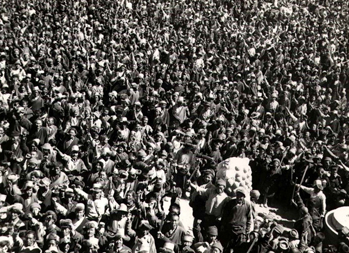 fairly large-scale "disturbances" had happened in Lhasa in 1987 and 1989, but, in the twenty years since then, the city had been stable. Sporadic skirmishes had never amounted to much, and the Chinese government's ideal of a "flourishing and harmonious society" seemed to be taking root. Usually, in early March, the streets, alleys, and monasteries of Lhasa are fairly quiet because many Tibetans go to the countryside for celebrations of the Lunar New Year in February and take their time coming back. But March is also the beginning of the tourist season; visitors from other provinces and countries begin to trickle in.
fairly large-scale "disturbances" had happened in Lhasa in 1987 and 1989, but, in the twenty years since then, the city had been stable. Sporadic skirmishes had never amounted to much, and the Chinese government's ideal of a "flourishing and harmonious society" seemed to be taking root. Usually, in early March, the streets, alleys, and monasteries of Lhasa are fairly quiet because many Tibetans go to the countryside for celebrations of the Lunar New Year in February and take their time coming back. But March is also the beginning of the tourist season; visitors from other provinces and countries begin to trickle in.
The city's tranquility in early March of this year could have made one wonder whether "March 10" had been forgotten. Only a few subtle signs on the government's part showed that anybody remembered. On March 7 a special deployment of police was assigned to national highway 318 that runs between Nepal and Lhasa. There is a checkpoint between the frontier pass at Dram-mo [Zhangmu] and the prefecture Nyingtri [Linzhi], where, under normal conditions, the driver of a car must alight to hand in paperwork to authorities. Beginning March 7, though, the new police detachment did things differently. Now inspectors approached every vehicle as it arrived, and cars that had Tibetan drivers received special attention. Each passenger was scrutinized. The authorities gave no reasons for the stricter measures, but they appear to have been a way of screening Tibetans who might be arriving from Nepal to observe "March 10."
Through most of the day of March 10, Lhasa was as placid as ever. Then, a bit after 4:00 p.m., three hundred monks came marching down from the Drepung Monastery in the nearby hills. They were chanting slogans for freedom of religion and against the migration of Han Chinese to Tibet. Military 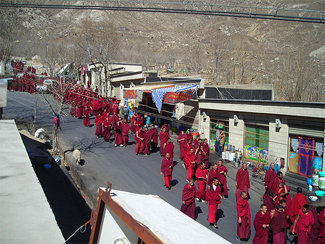 police blocked them at a checkpoint on the outskirts of the city. A few monks were arrested and driven away. For this, the rest sat down in silent protest. News of these happenings spread quickly, apparently by cell phone, and soon another one hundred monks emerged from Drepung. This group was blocked by military police at the foot of the hills before ever reaching the checkpoint. Police beat both groups of monks with clubs, and by 2:00 a.m. all of them had been forced back to their monastery. Also on March 10, at the Jokhang Temple Square at the center of the old city in downtown Lhasa, an enhanced police force went on duty. Plainclothes police--"undercover" but obvious to any Tibetan--were everywhere, as were military vehicles. It is never easy in Lhasa to distinguish among vehicles of the Peoples Armed Police, the Peoples Liberation Army, and Public Security. Some have special license plates; some use regular civilian plates; some have no plates at all, and others cover the ones that they do have. On March 10 I saw at the edge of the Jokhang Temple Square a minivan packed with uniformed police and riot gear. Up until about 5:00 p.m. the old city remained tranquil. Shoppers shopped as usual, and evening prayers were proceeding normally. I asked a few Tibetans if they still remembered "March 10" and they said things like "of course, how could we forget?," but they were not planning to do anything in particular about it. Most were heading home to light lamps and say prayers for the spirits of their deceased loved ones. Then, about 6:00 p.m., a small public protest broke out. About a dozen young monks--twenty, at most--emerged from the Sera Monastery, unfurled a Tibetan flag and shouted demands for a free Tibet. Instantly a swarm of police set upon them, beat them, arrested every one of them, and took them away. Tibetan bystanders watched, apparently immobilized by fear.
police blocked them at a checkpoint on the outskirts of the city. A few monks were arrested and driven away. For this, the rest sat down in silent protest. News of these happenings spread quickly, apparently by cell phone, and soon another one hundred monks emerged from Drepung. This group was blocked by military police at the foot of the hills before ever reaching the checkpoint. Police beat both groups of monks with clubs, and by 2:00 a.m. all of them had been forced back to their monastery. Also on March 10, at the Jokhang Temple Square at the center of the old city in downtown Lhasa, an enhanced police force went on duty. Plainclothes police--"undercover" but obvious to any Tibetan--were everywhere, as were military vehicles. It is never easy in Lhasa to distinguish among vehicles of the Peoples Armed Police, the Peoples Liberation Army, and Public Security. Some have special license plates; some use regular civilian plates; some have no plates at all, and others cover the ones that they do have. On March 10 I saw at the edge of the Jokhang Temple Square a minivan packed with uniformed police and riot gear. Up until about 5:00 p.m. the old city remained tranquil. Shoppers shopped as usual, and evening prayers were proceeding normally. I asked a few Tibetans if they still remembered "March 10" and they said things like "of course, how could we forget?," but they were not planning to do anything in particular about it. Most were heading home to light lamps and say prayers for the spirits of their deceased loved ones. Then, about 6:00 p.m., a small public protest broke out. About a dozen young monks--twenty, at most--emerged from the Sera Monastery, unfurled a Tibetan flag and shouted demands for a free Tibet. Instantly a swarm of police set upon them, beat them, arrested every one of them, and took them away. Tibetan bystanders watched, apparently immobilized by fear.
The news of this incident, too, spread quickly. Monks at the Jokhang Temple demanded that the Sera 3monks be released. When that was denied, the Jokhang monks began a hunger strike. At 10:00 p.m. downtown Lhasa was eerily quiet. A few policemen remained on guard outside the Jokhang Temple while a few Tibetans, wearing white head-scarves as a sign of mourning, bowed deeply, in silence, in front of the temple. But most Tibetans stayed at home, their doors and windows shut tight, lighting yak-butter lamps and saying their prayers. I heard one drunken Tibetan shouting “We Tibetans want freedom!” at passersby. Tibetans understood him, but Han Chinese who did not know Tibetan seemed to assume they were hearing only the ravings of an inebriate. In any case, in Lhasa, only drunkards dared to shout such things.
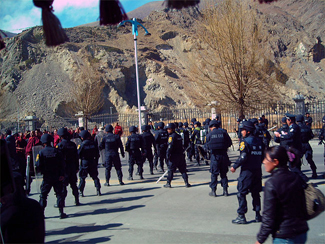 On the afternoon of March 11, the government put the Sera Monastery under emergency lock-down. A group of Tibetans at a driving school next to the monastery witnessed the crackdown and told me what they saw. They said monks had sat down outside the monastery, meditating in protest, when suddenly a large number of police cars surrounded them. Police demanded that they go inside, but they refused. The police then used tear gas and clubs to force them inside. The Tibetans who watched from the driving school were upset at this spectacle, and at one point set out to aid the monks, but were blocked when authorities at the driving school locked the gates of the premises and temporarily prevented anyone from leaving. The cell-phone wireless network in the area was also cut off, and the road that leads to the Sera Monastery was blocked. The Drepung Monastery had already been closed, the day before, but now the road leading to it was blocked as well.
On the afternoon of March 11, the government put the Sera Monastery under emergency lock-down. A group of Tibetans at a driving school next to the monastery witnessed the crackdown and told me what they saw. They said monks had sat down outside the monastery, meditating in protest, when suddenly a large number of police cars surrounded them. Police demanded that they go inside, but they refused. The police then used tear gas and clubs to force them inside. The Tibetans who watched from the driving school were upset at this spectacle, and at one point set out to aid the monks, but were blocked when authorities at the driving school locked the gates of the premises and temporarily prevented anyone from leaving. The cell-phone wireless network in the area was also cut off, and the road that leads to the Sera Monastery was blocked. The Drepung Monastery had already been closed, the day before, but now the road leading to it was blocked as well.
On March 12, a group of nuns from the Chubsang Nunnery in northern Lhasa began a trek toward downtown Lhasa. Police intercepted them, forced them to return, and proceeded to surround the Chubsang Nunnery. A few of the nuns somehow managed to elude police and found their way to the city center. On March 13 they staged a protest demonstration but it, too, was quickly snuffed out. It was also on March 12 that monks at Sera Monastery began a hunger strike and two monks from the Jokhang Temple were said to have slit their wrists. All monasteries in Lhasa were then put under lock-down, which meant not only that monks were forbidden from entering or leaving, but that food and water supplies were also suspended. That situation held for several days.
Around noon on March 14, after monks at the Ramoche Temple in Old Lhasa had finished their morning rituals, several of them suddenly went outside the temple, overturned the police cars that were stationed there, and then, as if nothing had happened, calmly walked back inside and continued to read their scriptures. The Ramoche Temple is always tightly guarded, but, because of its location near the center of Old Lhasa, most of the guards need to be disguised in civilian clothes. This makes the appearances more seemly, but the monks and other Tibetans are all quite clear who the police are. This was the context in which the first "riot" of March 14 occurred. About 1:00 p.m., Tibetans and monks from a small temple near Ramoche clashed with plainclothes police at the Ramoche gates. A few Tibetans sustained serious head injuries and were carried away by friends. A private residence next door to Ramoche happened at the time to be undergoing renovations. Angry Tibetans took bricks from the renovation site and used them to smash several nearby shops owned by Han Chinese. The trouble soon spread to the Tromsigkhang District, which lies to the south of Ramoche across Beijing Road. Strangely, the uniformed guards who had been stationed in front of Ramoche disappeared at this point, leaving behind only the plainclothes guards, who, when discovered by the incensed crowds, became their targets. The protestors moved slowly eastward along Beijing Road, passing the intersection with Shonu [=Youth in Tibetan, Qiannian lu] Road, which runs north and south. It is that strip of Shonu Road near Beijing Road that Chinese television later showed, over and over, as evidence of the "grave losses" that rioters had inflicted. The protesters then moved to the Tsomonling district, about a hundred meters beyond Shonu Road, and toward the center of Old Lhasa where the Barkor and Jokhang Square are located.
By 2:00 p.m. clouds of black smoke were rising along the route between the Tromsigkhang District and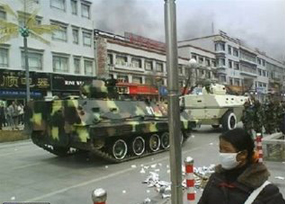 the Barkor. The public schools in Lhasa normally observe a noon recess, but that day, because of the disturbances, they all cancelled afternoon sessions and sent their young charges home. The protestors were targeting Han-owned shops, not children, so the youngsters walked home through all the turmoil as if charmed, and remained unscathed. Roadside shops began to close up, and crowds of Tibetan onlookers began to form. Vehicular traffic, which had been temporarily stopped, began to reappear from the eastern end of Beijing Road. The Tibetan crowds shouted taunts at Han Chinese who passed by on motorcycles, but they spared tourists, and were especially careful not to affront Western tourists. At the intersection of Beijing Road and Shonu Road about ten policemen directed traffic but, strangely, did nothing to intervene in the rioting. At one point when the rioters suddenly turned westward, in the direction of the policemen, they seemed to panic. They scurried from the center of the road and disappeared into alleys, seemingly more fearful than were all the curious onlookers. I heard a tourist ask a policeman for assistance in returning to a hotel at the eastern end of Beijing Road. "We're busy enough just trying to take care of ourselves here,” the policeman said. “How do you think we can care for you?" The police, including the military police, were trying to control only certain stretches of road. Elsewhere they occasionally tossed a tear-gas grenade into a crowd, but that was about all. The Tibetan rioters rarely sought to confront the police, either. It was almost as if the rioters and the police had agreed to disagree and let each side attend to its own business. I saw a convoy of government cars and police cars turn south from Beijing Road toward Yuthok Road passing right through a knot of rioters. Neither side seemed to pay any attention.
the Barkor. The public schools in Lhasa normally observe a noon recess, but that day, because of the disturbances, they all cancelled afternoon sessions and sent their young charges home. The protestors were targeting Han-owned shops, not children, so the youngsters walked home through all the turmoil as if charmed, and remained unscathed. Roadside shops began to close up, and crowds of Tibetan onlookers began to form. Vehicular traffic, which had been temporarily stopped, began to reappear from the eastern end of Beijing Road. The Tibetan crowds shouted taunts at Han Chinese who passed by on motorcycles, but they spared tourists, and were especially careful not to affront Western tourists. At the intersection of Beijing Road and Shonu Road about ten policemen directed traffic but, strangely, did nothing to intervene in the rioting. At one point when the rioters suddenly turned westward, in the direction of the policemen, they seemed to panic. They scurried from the center of the road and disappeared into alleys, seemingly more fearful than were all the curious onlookers. I heard a tourist ask a policeman for assistance in returning to a hotel at the eastern end of Beijing Road. "We're busy enough just trying to take care of ourselves here,” the policeman said. “How do you think we can care for you?" The police, including the military police, were trying to control only certain stretches of road. Elsewhere they occasionally tossed a tear-gas grenade into a crowd, but that was about all. The Tibetan rioters rarely sought to confront the police, either. It was almost as if the rioters and the police had agreed to disagree and let each side attend to its own business. I saw a convoy of government cars and police cars turn south from Beijing Road toward Yuthok Road passing right through a knot of rioters. Neither side seemed to pay any attention.
Suddenly, about 200 meters to the west, near the junction of Beijing Road and Nyangdren Road, I could see that a contingent of People's Armed Police had appeared in helmets and shields. Then about fifty meters farther east, at the junction with Kharnga Shar Lam (East Castle Road), which is also the eastern edge of Potala Square, more rows of military police appeared, and large armored vehicles lined the streets. A stream of military vehicles arrived steadily from the west along Beijing Road; when they reached the junction with Kharnga Shar Lam they turned south toward Chingdrol 'Liberation’ Road. All of these vehicles, whether armed or not, were military vehicles. I saw no fire engines or ambulances, even though, at that time in the eastern part of the city, several fires were already burning and a number of Han Chinese had already been injured. Potala Square is the seat of the Tibetan government, and the stretch of Beijing Road that runs east from it contains several large buildings housing the Bank of China, the Bank of Agriculture, the central post office, and Lhasa’s largest shopping center. It was, in short, the obvious place for troops to protect. Shortly after 3:00 p.m., when the rioting was still confined to the eastern side of Shonu Road, the soldiers at Nyangdren Road were already shooing bystanders westward toward the far side of Potala Square. They were also stopping anyone they could from using cameras or cell phones to take photographs. Around 4:00 p.m. soldiers blocked off Beijing Road eastward from Potala Square. Meanwhile the disturbances had crossed to the west side of Shonu Road. An hour later they had spread to Lingkor Central Road, northward to the area of New Unity Village, and eastward as far as the Karma Kunsang area. These were the areas most affected by the rioting.
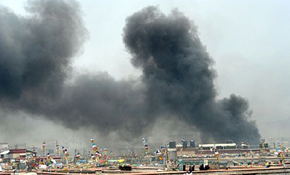 One reason why the riots spread as far as they did was that Chinese troops apparently did not dare to carry out major repression while Western tourists were watching. There was very little gunfire anywhere along Beijing Road, where the tourists were most numerous. But some Tibetans were shot to death elsewhere. A witness told me that he had seen military police kill at least four or five Tibetans at Lingkor Road about 5:00 p.m. At the Barkor, police shot and killed a nun whose family then carried her body inside their home; that evening police came to the door, entered forcibly, and removed the body. With the arrival of nightfall, when the tourists were in their hotels and out of sight, gunfire in the city increased.
One reason why the riots spread as far as they did was that Chinese troops apparently did not dare to carry out major repression while Western tourists were watching. There was very little gunfire anywhere along Beijing Road, where the tourists were most numerous. But some Tibetans were shot to death elsewhere. A witness told me that he had seen military police kill at least four or five Tibetans at Lingkor Road about 5:00 p.m. At the Barkor, police shot and killed a nun whose family then carried her body inside their home; that evening police came to the door, entered forcibly, and removed the body. With the arrival of nightfall, when the tourists were in their hotels and out of sight, gunfire in the city increased.
The city of Lhasa usually bustles at night, but that night the area of Lhasa west of Potala Square, where I was at the time, was shrouded in a ghostly silence. I took a taxi eastward but could go only as far as Dekyi Lingka Road. From there, as I walked farther eastward, I saw only empty streets and an occasional pedestrian. At the eastern edge of Potala Square, the legion of military police and their vehicles were still blocking the roadways out of the square. Walking farther along Beijing Road, for the next 50 meters or so, I saw heavy damage to stores on the north side of the road, while stores on the south side seem not to have been touched. I heard from passersby that the rioters had crossed west of Shonu Road only briefly and then turned back, apparently to avoid confrontation with the troops stationed at Potala Square. I saw bloodstains on the streets, but, to judge from their size, the bloodshed had not been great. This was the stretch of road that included the Yichun Clothes Shop where five Han Chinese girls had died in a fire. Their charred remains were shown over and over on television throughout China in the days that followed. The damage to stores at the junction of Shonu Road was also severe, especially to the north of the crossroads, but not so much to the south. The burnt remains of a white car rested on the sidewalk at the intersection. This was also the area that contained the shop of the Han Chinese “Mr. Peng,” whose losses were shown repeatedly on China’s state television. The area to the east of Shonu Road had been hardest it by the rioting on the afternoon of March 14.
Now, at shortly before midnight, the streets were empty. Only the intermittent crackle of gunfire broke the silence, as did, occasionally, a chilling scream. The most incessant gunfire that night was in the Tibetan district of Old Lhasa. Early the next morning, March 15, this district was put under martial law. Ordinary people, whether they had identification documents or not, were not allowed to enter or leave the area, and those inside it were discouraged from going onto the streets. People who left home to buy food were sent back. Cell phones were examined for unauthorized photography. These rules were applied to Hans and Tibetans alike. Black smoke arose from the area from time to time throughout the day, and sporadic gunfire rang out as well. These conditions remained essentially the same through the next day, March 16. For those two days, March 15 and 16, only the occasional sound of gunfire disturbed the tomb-like silence. No one answered the telephone at the police department’s emergency number--or, for that matter, at the number of any government office. On those two days all government resources seemed to be devoted to a dragnet in which the local police and the People’s Armed Police looked for “violent thugs”. On March 16 some Han Chinese whose shops on Shonu Road had been smashed two days earlier wanted to go out to buy some food, but police blocked them, denied permission for their shopping trip, and confiscated a cell phone that one of them was carrying.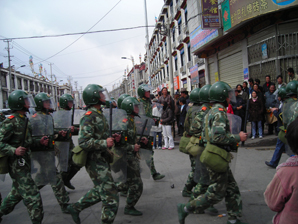
The real searching, though, was in the Tibetan neighborhoods. Armed police went door to door looking for suspects in the rioting and for pictures of the Dalai Lama--which were the primary grounds for making one into a suspect. A story spread that in one Tibetan home the police found a photograph of the Dalai Lama and demanded that the owner throw it onto the floor and trample it; when the man refused, police beat his hands until bones broke. Some Tibetan families made the painful decision to burn their photos of the Dalai Lama. On the afternoon of March 16 there was an announcement that martial law would be lifted the next day. Small buses carrying people with shovels and brooms appeared on the streets of Old Lhasa. These people seemed to have been mobilized from government work units to go clean up the mess on the streets.
On March 17 martial law was officially lifted but Old Lhasa was still guarded by military police. Passersby had to show valid identification and no one could go to work without a work-unit ID. In Tibetan neighborhoods there was no real change from the martial-law regimen: armed police were still stationed at every intersection and patrols roamed even the smallest of alleyways. Tibetan parents were not allowed to accompany their children on the walk to school. Tibetans who appeared in public were subject to search of their persons and of any items that they carried. Necks, in particular, were examined to see if anyone still dared to wear a Dalai Lama pendant. If so it was confiscated. By then, though, most people had figured out not to wear pendants.
On the same day, March 17, a media barrage on television and radio and in the newspapers showed, showed and re-showed scenes of Tibetans beating up Han Chinese. Most of the Hans were plainclothes police whom angry crowds had identified and surrounded. But some of the Han victims were just ordinary citizens. We Tibetans must face this fact. We should acknowledge, too, that Tibetans smashed and set fire to shops owned by Han and Moslem Chinese. We might explain these actions by saying they were irrational outbursts that sprang from many years of frustration. But still it was wrong, and it was painful to watch.
Some of what the Chinese media showed, however, was highly misleading and, I believe, probably fabricated for the purpose of showing to the rest of China. Angry Tibetans did burn and smash Han shops, but they did not, as the media claimed, steal anything. They sometimes removed goods from shops, put them onto the street and set them afire, but they did not take anything home. If any looting by Tibetans had begun, I feel certain that other Tibetans would have stopped it, and indeed would have angrily chastised the offender for corrupting the spirit of the protest. Material loot was not the point of the riots--indeed was quite far from the point. The Chinese media's attempt to present it this way was cynical deception. The media's reference to the Tibetans on the street "violent thugs" was a further deception, because this term, in normal Chinese use, suggests that a person is willing to kill. But none of the filmed footage showed anyone being beaten to death, and, in the minds of the overwhelming majority of Tibetans, to do such a thing would violate the fundamental principles of living as a human being. If a Tibetan had begun to do such a thing, others would certainly have stopped him.
The Chinese media images of shops and homes devastated by fire raises a number of other troubling questions. How, for example, could the damage have been so extensive? On March 14, when the burning happened, the Tibetan rioters who were moving westward reached the Tsomonling area at just past 1:00 p.m. By 3:00 p.m. they still had not crossed Shonu Road, where police crews were already in place. One block farther west, the Peoples Armed Police were already deployed and at the ready. So how could this area have been one where the damage was most severe? Even if we consider that, it being daylight, the troops did not want to use violence in front of the cameras of tourists, they still could have used tear gas or water hoses to prevent major arson. Another puzzle is why, when houses were set ablaze in the Tromsigkhang area, the homes of both Tibetans and Hans were burned. Why would Tibetans burn the homes of Tibetans? It is not plausible that they could not tell the difference. When shops were set ablaze on Shonu Road, the ones owned by Tibetans were left untouched even if the neighboring shops on both sides, if owned by Hans, were burned. It is at least as easy to recognize a Tibetan home as a Tibetan shop.
One image that was shown repeatedly all across China, and internationally, showed a "Tibetan" wielding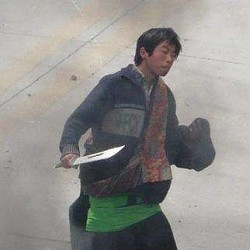 a machete. He was wearing clothing characteristic of people from the Amdo region in northeast Tibet, but his face did not look like an Amdo Tibetan face and the big knife that he held was one that no Tibetan would recognize. Moreover the aim of the rioters on March 14 was to smash shops, a task for which a big knife like that would have been a clumsy tool. Using it would likely have resulted in damage to the knife itself. Are we supposed to believe that the purpose of the knife was to hack Han Chinese? I cannot. There is no evidence that the rioters, for all their anger, had that kind of bloodthirsty goal.
a machete. He was wearing clothing characteristic of people from the Amdo region in northeast Tibet, but his face did not look like an Amdo Tibetan face and the big knife that he held was one that no Tibetan would recognize. Moreover the aim of the rioters on March 14 was to smash shops, a task for which a big knife like that would have been a clumsy tool. Using it would likely have resulted in damage to the knife itself. Are we supposed to believe that the purpose of the knife was to hack Han Chinese? I cannot. There is no evidence that the rioters, for all their anger, had that kind of bloodthirsty goal.
What the official media showed about the Han people who died in fires raises yet other questions. The deaths are as shocking as the questions are unsettling. The two places where Hans died in fires were on Shonu Road north of Beijing Road and on Beijing Road to the west of Shonu Road. These were both locations where the police were already in place, and the armed militia was nearby, well before the rioters arrived. Moreover the elapsed time between the point at which it was known that rioting had begun in the city and the point at which the slow-moving rioters arrived at these two locations was about two hours. That was plenty of time to do an evacuation. People on the streets at the two locations--Hans and Tibetans alike--were moving freely during those two hours. How, as the media reports said, could the fire victims have been trapped inside their shops? One of the stores in which people died, the Yichun Clothes Shop, was only about 100 meters away from where the Peoples Armed Police were on duty, and yet there seems to have been no effort to evacuate or rescue anyone. On Yuthok Road as well, where a number of government offices suffered heavy damage, as did about one third of the Han-owned shops, other nearby shops and offices suffered no damage at all. The puzzle is that police, including military police, were stationed throughout the area--both where damage occurred and where it did not occur. In some areas the police deterred rioters; in others they stood by and watched. The Chinese media has repeated endlessly that the disturbances had been "plotted, planned, and organized" by the Dalai Lama. But looking at the streets of Lhasa, it seemed much more likely that someone else had done some planning and organizing.
One of the official news reports claimed that Tibetans had set fire to a school. It is true that a school was burned. But that had happened when flames spread from neighboring shops. I find it impossible to imagine that Tibetans deliberately set fire to a school. Moreover one could see from the news clip that only part of the second floor of the school building showed signs of having been burned. Would someone aiming to burn down a building begin at the second floor? Chinese television interviewed some Tibetan witnesses who condemned "the arson," but only a viewer bilingual in Tibetan and Chinese could know that the Chinese subtitles were a poor match what the Tibetans were saying.
In the days that followed March 18, life in Lhasa seemed to calm down. The government announced that "the people's lives and production have been restored to normal order." But the description was superficial. The tension caused by the military crackdown had not diminished. Troops continued to occupy Tibetan neighborhoods, and the household searches, and arrests of Tibetans, continued as before. The arrests from March 15 to 18 had been done by uniformed police; now they were done, more furtively, by plainclothes police. Once arrested, it seemed to matter little whether a person could show that he or she had had nothing to do with the rioting; a beating followed in either case. I interviewed a Tibetan who had been released from a detention center because he was able to show clear evidence that he had been elsewhere when the rioting occurred. His face was still badly swollen from beatings. But he said that the great majority of Tibetans inside his detention center were determined to stay optimistic. Some young Tibetan women detainees, he said, sang songs all day long in an effort to boost everyone's spirits.
He introduced me to another Tibetan who had entered the detention center in good health but came out 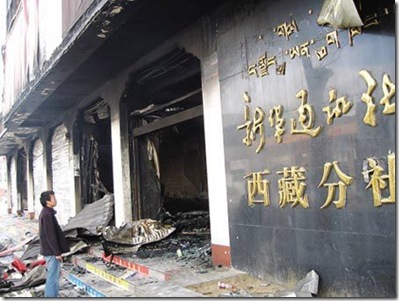 unable to walk and mentally disoriented. This man died two days later. People have asked me how many Tibetans were arrested, all together, and how many died in both the night-time shootings and the detention centers. I do know, and I am not optimistic that this number will ever be precisely known. The police presented inducements to detainees as well as coercion. They offered rewards of 2000 yuan (about $285) for information that led to the arrest of a rioter. A few Tibetans apparently took this offer, but not many. The Public Security Office of the Tibet Autonomous Region also sent a text message to every cell-phone subscriber in Lhasa announcing a reward of 20,000 yuan for anyone who could turn over a person on the government's "most wanted" list. Photographs of people on this list were broadcast on television every night beginning March 19, with exceptions only of a brief suspension when foreign journalists and diplomats were being given guided tours to show that all was well in Lhasa.
unable to walk and mentally disoriented. This man died two days later. People have asked me how many Tibetans were arrested, all together, and how many died in both the night-time shootings and the detention centers. I do know, and I am not optimistic that this number will ever be precisely known. The police presented inducements to detainees as well as coercion. They offered rewards of 2000 yuan (about $285) for information that led to the arrest of a rioter. A few Tibetans apparently took this offer, but not many. The Public Security Office of the Tibet Autonomous Region also sent a text message to every cell-phone subscriber in Lhasa announcing a reward of 20,000 yuan for anyone who could turn over a person on the government's "most wanted" list. Photographs of people on this list were broadcast on television every night beginning March 19, with exceptions only of a brief suspension when foreign journalists and diplomats were being given guided tours to show that all was well in Lhasa.
On March 27, when the foreign journalists arrived for their tour, Potala Square, which for days had been bleak and barren, suddenly teemed with Tibetans saying their ritual prayers. The journalists could not have known that government officials had gone to Tibetan neighborhoods the day before with orders that people go say prayers at Potala Square and that they provided "reimbursements" of 200 yuan apiece for those who complied. In normal times the people of Lhasa might have found this charade to be funny, but now the whole thing was laced with the sharp edge of fear. Another small riot broke out on March 29. It was said that three people were beaten to death, but I cannot confirm that. I can say, though, that I saw all the shops on Beijing Road close up within half an hour. The residents of Lhasa had become much more sensitive and quick to react than they had been on March 14. Other than that, I can say only that extra police were visible on the streets. Very quickly, there was no sign that any riot had taken place; the government's reaction this time was entirely different from what it had been on March 14. In early April there were still more police than usual patrolling the streets of Lhasa. No one knows when martial law will be entirely removed. Tibetans have long had to carry identifications card when they go out of their homes; now, in addition, they have had to carry temporary residence cards that the government has required them obtain in the wake of "March 14." Tibetans outside of Lhasa cannot visit the city's temples now, and do not know when they will next be allowed to do so.
One of the chants that Tibetans used during the protests between March 10 and 13 was: “We are the spirits of the people you killed 49 years ago! We are not afraid of death! If you kill us again, we will only come back again!” To Tibetans, it is not only the lamas who can be reincarnated. Any soul who draws strength from a sacred cause can do this. For them, the sacred cause is freedom.
This account by a Tibetan eyewitness to the events of March 2008 in Lhasa was translated from Chinese.Click here to read the original.